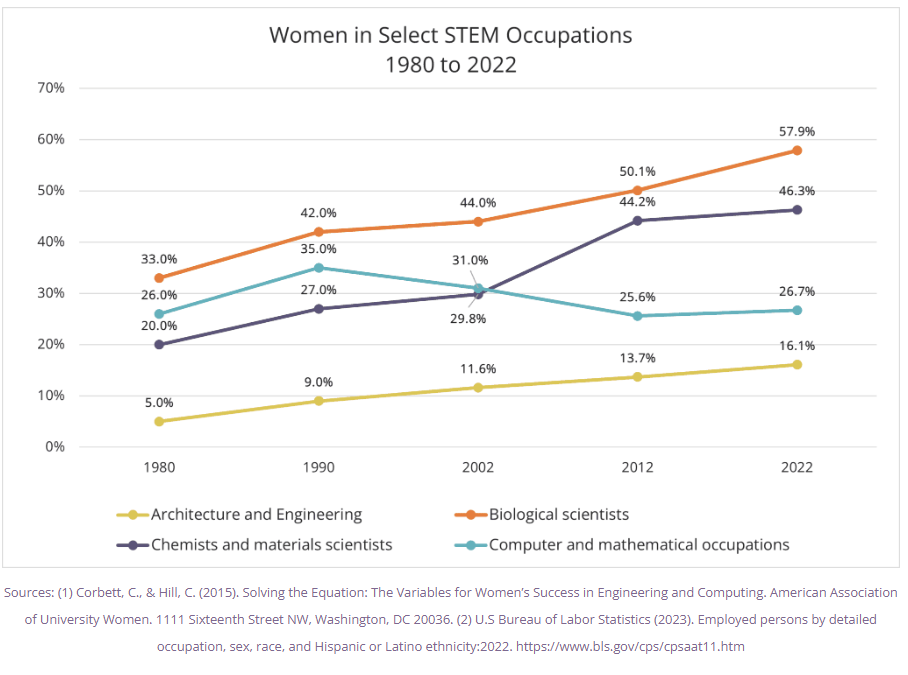
International Women’s Day is an important time to honor the achievements women have brought to our culture, technology, industry, and society. Throughout history, the achievements of women have often been downplayed or hidden, replaced by their male peers, or simply not given the acknowledgment and honor that they deserved. We like to say that this is the twentieth century, and things are different, but even so, we, and I use that as a universal we, are still far behind the equality and societal respect that women have earned.
International Women’s Day began in the Women’s Rights Movement to bring attention to important societal issues such as gender equality, reproductive rights, and violence and abuse against women. Furthered by the universal suffrage movement, International Women’s Day came out of major labor movements in North America and Europe during the 20th century.

This day still holds strong in our global zeitgeist in putting a spotlight on the work that remains to be done to give women the opportunities they deserve, and provide young women with the education and support to reach for their dreams and take on roles in industries that have been traditionally dominated by men. It is key to these initiatives that women be given the support from early on to pursue mathematics, engineering, and STEM, and then make a welcoming environment for women to be able to find their stride and shine.
Originating in 1909 in the United States, the Socialist Party of America chose February 28th to honor the women of 1908 garment workers’ strike in New York against terrible working conditions.
The light of this event was first sparked years earlier in 1848 when women two women, Elizabeth Cady Stanton and Lucretia Mott, organized the first women’s rights convention in New York. They demanded civil, social, political, and religious rights for women in the Declaration of Sentiments and Resolutions. This gave a voice to women who had been searching for the catalyst to push for fair and equal treatment.
The United Nations shares how this day grew into the modern era;
After World War II, 8 March started to be celebrated in a number of countries. In 1975, during the International Women's Year, the United Nations began celebrating 8 March as International Women's Day. Two years later, in December 1977, the General Assembly adopted a resolution proclaiming a United Nations Day for Women's Rights and International Peace to be observed on any day of the year by Member States, in accordance with their historical and national traditions. Since then, the United Nations and their agencies have worked tirelessly to secure gender equality worldwide with great outcomes achieved: in 1995 the Beijing Declaration and Platform for Action, a historic roadmap signed by 189 governments, focused on 12 critical areas of concern; and the inclusion of Goal 5 “Achieve gender equality and empower all women and girls” in the 2030 Agenda for Sustainable Development. (https://www.un.org/en/observances/womens-day/background)
Helping give women a voice in the industry
Manufacturing and engineering continue to be male-dominated. However, great strides have been made to diversify these industries and professions. These numbers only reflect the United States and show that women represent approximately 34% of all STEM workers in 2019. This overshadows the fact that within engineering, women are still poorly represented, with women represented by only 16.1% of engineers. This highlights how much work there still is to do in making a welcoming environment for women and encouraging young women to pursue these careers.

In manufacturing in general, women are still poorly represented. From Commerce.gov and census data collected in the US, we see that women in manufacturing:
Why is it important to help women enter manufacturing and engineering?
Besides the obvious answer that women deserve the same opportunities and experiences as men do, bringing diversity into the workplace has proven to deliver a variety of additional benefits.
Manufacturers have found that gender diversity boosts morale and retention. (https://www.commerce.gov/news/blog/2021/03/making-place-women-manufacturing). Manufacturing jobs provide excellent wages and an opportunity for good pay, benefits, and career opportunities for professionals with, and without, a college degree. These jobs also tend to pay more and offer more benefits than jobs in the service sector, where the majority of women are employed. With the advancements in technology, many of these jobs are much less hazardous and physically intensive than they used to be, instead focusing on managing machines, robots, and roles in marketing, sales, administration, finance, and cybersecurity.
DCS, a SANDVIK company and member of SME, SAE, and AIAG, tries to provide a place for women to find a fulfilling professional career. As part of this effort, DCS has supported the Society of Women Engineers, as well as IEEE Women in Engineering, and other groups supporting women in manufacturing and engineering.
DCS’s sister companies have also worked to promote women and make an equitable working place.
"At Metrologic Group, we think that empowering and supporting women in becoming the leaders for the future of the industry is very important. Because diversity brings new vision, creativity and innovation!
At Metrologic Group, we know there is still work to do to reach equality in the industrial work for women. And we want to be an active actor in this change.
At Metrologic Group, today and any day, we are thankful for all the amazing women working with us and helping us to build the future of 3D metrology."
Sandvik has a long history and active work on Diversity and Inclusion. We know that it’s key for success. That’s why we have embedded D&I into our values, into the Sandvik Shift and into our people strategy.
“Adding Equity is simply an obvious step forward and part of our stated goal to become the employer of choice within the industry,” says Angela Kristiansson.
Her role as Employee Experience Expert is new within HR and fully committed to embrace the experience of the employee, in everything that make the engagement retain to how you belong, perform and get rewarded.
“This we want to do in a way that promotes diversity, inclusion and equity. From experience we know that D&I increases team effectiveness, innovation and employee engagement as well as the customer experiences. It gives us a competitive edge,” says Kristiansson.
If diversity means to recognize that every individual is unique and brings different things to the table, inclusion is about the behavior. It’s about embracing that everyone, regardless of who they are, who they love, or what they believe can contribute to the company’s success.
Many groups have begun programs in order to reach women at an early stage in their education and careers. Engineering is still the most male-dominated field in STEM. Many actions have been taken to attract women to engineering, but despite 20% of engineering graduates being women, almost 40% of women who earn their engineering degrees either quit or never enter the profession.
The Harvard Business Review explores this issue in education (https://hbr.org/2016/08/why-do-so-many-women-who-study-engineering-leave-the-field). What they found is that despite women performing better than their male counterparts in school, they most often find the ingrained masculine culture of engineering as being unwelcoming and harmful. This pushes most women to leave early in their careers and continues to perpetuate the problem.
Groups like SME, SWE, and IEEE are working to solve this cultural issue. As advocates and catalysts for change by providing a combined voice for women who often feel alone in their positions, these organizations connect women and provide resources, support, and engines for change.
Women have been foundational in many engineering and technological advancements. SME brings a spotlight on some of these women (https://www.sme.org/aboutsme/women-influencing-manufacturing/women-influencing-manufacturing/), and is working with others to continue to support women and their stories to continue this trend and try to improve the culture and environment young women engineers find themselves in.
Other companies, like GoldieBlox (https://goldieblox.com/) , seek to provide a window into manufacturing and engineering for young girls to help them see a future for themselves in these professions. Traditionally, many women are steered away from STEM at a very early age, and these companies are working to break cultural barriers while providing new dreams and experiences for young girls to see themselves as inventors, makers, and builders while experiencing technology earlier in their lives.
Large systemic issues can feel daunting. It is hard to see your actions as contributing to a solution, as the problem often seems insurmountable. It is key to remember that large problems are not solved by large solutions, but by many small solutions together. Promoting diversity in your workplace, helping new women employees feel welcome, working with organizations to support women in the workplace, and pushing lawmakers to reduce barriers for women to enter the workforce by supporting education, families, and accountability for poor behavior all help women gain the opportunity to find their careers in STEM and help everyone create a more diverse, welcoming, and productive world.
These Stories on Press Release
No Comments Yet
Let us know what you think